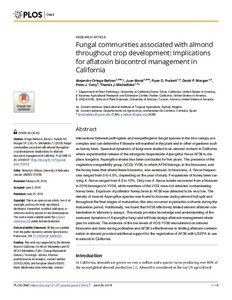| dc.contributor.author | Ortega-Beltran, A. |
| dc.contributor.author | Moral, J. |
| dc.contributor.author | Puckett, R.D. |
| dc.contributor.author | Morgan, D.P. |
| dc.contributor.author | Cotty, P. |
| dc.contributor.author | Michailides, T. |
| dc.date.accessioned | 2019-12-04T11:23:38Z |
| dc.date.available | 2019-12-04T11:23:38Z |
| dc.date.issued | 2018-06-20 |
| dc.identifier.citation | Ortega-Beltran, A., Moral, J., Puckett, R.D., Morgan, D.P., Cotty, P.J., Michailides, T.J. (2018). Fungal communities associated with almond throughout crop development: implications for aflatoxin biocontrol management in California. PLoS ONE 13(6), 1-15 |
| dc.identifier.issn | 1932-6203 |
| dc.identifier.uri | https://hdl.handle.net/20.500.12478/4079 |
| dc.description | Open Access Journal |
| dc.description.abstract | Interactions between pathogenic and nonpathogenic fungal species in the tree canopy are complex and can determine if disease will manifest in the plant and in other organisms such as honey bees. Seasonal dynamics of fungi were studied in an almond orchard in California where experimental release of the atoxigenic biopesticide Aspergillus flavus AF36 to displace toxigenic Aspergillus strains has been conducted for five years. The presence of the vegetative compatibility group (VCG) YV36, to which AF36 belongs, in the blossoms, and the honey bees that attend these blossoms, was assessed. In blossoms, A. flavus frequencies ranged from 0 to 4.5%, depending on the year of study. Frequencies of honey bees carrying A. flavus ranged from 6.5 to 10%. Only one A. flavus isolate recovered from a blossom in 2016 belonged to YV36, while members of the VCG were not detected contaminating honey bees. Exposure of pollinator honey bees to AF36 was detected to be very low. The density of several Aspergillus species was found to increase during almond hull split and throughout the final stages of maturation; this also occurred in pistachio orchards during the maturation period. Additionally, we found that AF36 effectively limited almond aflatoxin contamination in laboratory assays. This study provides knowledge and understanding of the seasonal dynamics of Aspergillus fungi and will help design aflatoxin management strategies for almond. The evidence of the low levels of VCG YV36 encountered on almond blossoms and bees during pollination and AF36’s effectiveness in limiting aflatoxin contamination in almond provided additional support for the registration of AF36 with USEPA to use in almond in California. |
| dc.description.sponsorship | Almond Board of California |
| dc.format.extent | 1-15 |
| dc.language.iso | en |
| dc.subject | Almonds |
| dc.subject | Aflatoxins |
| dc.subject | Honey Bees |
| dc.subject | Aspergillus Flavus |
| dc.subject | California |
| dc.title | Fungal communities associated with almond throughout crop development: implications for aflatoxin biocontrol management in California |
| dc.type | Journal Article |
| dc.description.version | Peer Review |
| cg.contributor.crp | Agriculture for Nutrition and Health |
| cg.contributor.affiliation | International Institute of Tropical Agriculture |
| cg.contributor.affiliation | Kearney Agricultural Research and Extension Center |
| cg.contributor.affiliation | University of Arizona |
| cg.coverage.region | Acp |
| cg.coverage.region | North America |
| cg.coverage.country | United States |
| cg.creator.identifier | Alejandro Ortega-Beltran: 0000-0003-3747-8094 |
| cg.researchtheme | PLANT PRODUCTION & HEALTH |
| cg.isijournal | ISI Journal |
| cg.authorship.types | CGIAR and developing country institute |
| cg.iitasubject | Aflatoxin |
| cg.iitasubject | Disease Control |
| cg.iitasubject | Plant Health |
| cg.iitasubject | Plant Production |
| cg.journal | PloS ONE |
| cg.howpublished | Formally Published |
| cg.accessibilitystatus | Open Access |
| local.dspaceid | 99390 |
| cg.targetaudience | Scientists |
| cg.identifier.doi | https://dx.doi.org/10.1371/journal. pone.0199127 |

